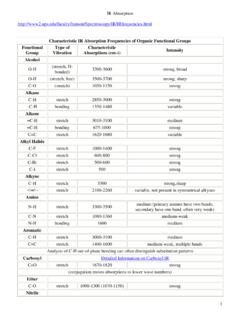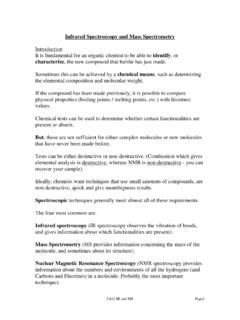Transcription of Spartan Student Tutorials
1 Spartan Student Tutorials WAVEFUNCTION. Wavefunction, Inc. 18401 Von Karman Avenue, Suite 370. Irvine, CA 92612 Wavefunction, Inc., Japan Branch Office 3-5-2, Kouji-machi, Suite 608. Chiyoda-ku, Tokyo, Japan 102-0083. Spartan Student is a collaboration with Q-Chem, Inc. TM. A Quantum Leap Into the Future of Chemistr y Q-CHEM, INC. 6601 Owens Drive, Suite 105. Pleasanton, CA 94588. Copyright 2002-2014 by Wavefunction, Inc. All rights reserved in all countries. No part of this book may be reproduced in any form or by any electronic or mechanical means including information storage and retrieval systems without permission in writing from the publisher, except by a reviewer who may quote brief passages in a review. Getting Started The Tutorials that follow provide a brief introduction to both the user interface and the calculation capabilities of Spartan Student .
2 The intent is to provide hands-on experience with the user interface and in doing so, illustrate the set up, submission, and interpretation of molecular mechanics and quantum chemical calculations. Tutorials are not intended to illustrate the full range of capabilities available in Spartan Student , but focus on building and sketching a variety of molecules and on use of the program to calculate equilibrium and transition-state geometries, to search conformation space, to align molecules, to evaluate reaction thermochemistry and activation energetics and to obtain NMR and infrared spectra. Walking Through Spartan Student (Chapter 1) provides a guided tour through some of the most rudimentary operations of the program. No molecules are built or stretched and no calculations are performed.
3 Rather, molecular structures, properties and spectra resulting from calculations are examined as are graphical models for the description of charge distribution and chemical reactivity. Building Organic Molecules (Chapter 2) and Stretching Organic Molecules (Chapter 3) present alternative ways to specify molecular structure, the first step in performing a molecular mechanics or quantum chemical calculation. The 3D building paradigm is quite general and Spartan Student provides tools not only for building organic molecules (described in Chapter 2) but also for inorganic and organometallic molecules and for polypeptides and polynucleotides. However, building in 3D may be unfamiliar or uncomfortable for many organic chemists, who have been taught to draw molecules in 2D on paper or on a whiteboard.
4 The advantage of 2D sketching over 3D building becomes more and more evident as molecular size and complexity increase, and with the rapidly growing popularity of touch-screen tablets and Windows PC's. The Tutorials in these chapters are limited to building/sketching and do not involve either calculations or examining the results of calculations. Getting Started i The Tutorials in Spectra, Properties, and Graphical Models of Organic Molecules from the Database (Chapter 4) and Spectra, Properties and Graphical Models from Quantum Chemical Calculations (Chapter 5) make use of the same molecules built or sketched in the previous chapters, but now the focus is on obtaining and interpreting the results of calculations. The Tutorials in Groups of Organic Molecules (Chapter 6) introduce multi-molecule documents and associated spreadsheet, plotting and analysis tools available in Spartan Student for data handling.
5 In order to save time, no quantum chemical calculations are required with all results being drawn from the database. The Tutorials in Spectra of Organic Molecules (Chapter 7) further illustrate the use of Spartan Student to interpret infrared spectra and to assist in the assignment of NMR spectra. All of the molecules considered up to this point are either rigid or have been assumed to exist in a single conformer. In reality, most molecules may adopt more than one conformation. The Tutorials in Flexible Molecules (Chapter 8) illustrate how to examine the conformational profile of a molecule with only a single rotatable bond, how to assign the lowest-energy conformer of a molecule with multiple degrees of freedom and how to interpret the NMR spectrum of a flexible molecule. Organic Reactions (Chapter 9) illustrates two approaches available in Spartan Student for finding the transition state for an organic reaction.
6 The first starts from a guess based on the structure of the reactant together with a set of reaction arrows , while the second moves a geometrical variable through the transition state. Applications to proteins and nucleotides are provided in Biomolecules (Chapter 10). Access to the PDB is illustrated. Finally, Inorganic and Organometallic Molecules (Chapter 11). illustrates the inorganic model kit available in Spartan Student . It also provides an example of a transition state for an organometallic reaction. ii Getting Started Table of Contents Chapter 1 Walking Through 1. Chapter 2 Building Organic 20. Organic Model 20. 1. 23. 2. 25. 3. 25. 4. 26. Chapter 3 Sketching Organic 28. Sketch 28. Sketching a 29. Manipulating a 29. 1. N, 30. 2. 30. 3. 31. 4. 3-Cyano-4-cyclohexenyl 32.
7 5. 33. Chapter 4 Spectra, Properties and Graphical Models of Organic Molecules from the 36. 1. 36. 2. 38. 3. 39. 4. 40. 5. N, 42. 6. 43. Chapter 5 Spectra, Properties and Graphical Models of Organic Molecules from Quantum Chemical 45. 1. 45. 2. 50. 3. 3-Cyano-4-methylcyclohexenyl 52. Table of Contents iii Chapter 6 Groups of Organic 55. Dienophiles in Diels-Alder 56. Addition vs. 60. Acidities of Carboxylic 62. Chapter 7 Spectra of Organic 65. infrared Spectrum of Methyl 65. Proton NMR Spectrum of 68. 13. C NMR Spectrum of 71. Stereochemical Assignments from 13C 73. Chapter 8 Flexible 75. Internal Rotation in 75. 79. 13. C NMR Spectrum of cis-1, 80. Chapter 9 Organic 82. Ene Reaction of 83. SN2 Reaction of Bromide and Methyl 86. Chapter 10 91. Structural Motifs in 91. Structure of 96.
8 Chapter 11 Inorganic and Organometallic 99. Sulfur 99. Benzene Chromium 102. Ziegler-Natta Polymerization of 104. iv Table of Contents Chapter 1. Walking Through Spartan Student This chapter, in the form of a tutorial, introduces a number of basic operations in Spartan Student required for molecule manipulation, property query and spectra and graphics display. Specifically it shows how to: i) open molecules, ii) view different models and manipulate molecules on screen, iii) measure bond distances, angles and dihedral angles, iv) display energies, dipole moments, atomic charges and infrared and NMR spectra, and v) display graphical surfaces and property maps. Spreadsheet operations are not illustrated, no molecules are sketched or built and no quantum chemical calculations are performed.
9 1. Start Spartan Student . Click (left mouse button) on File from the menu bar that appears at the top of Spartan Student 's main window. Click on from the File menu that appears. Alternatively, click on the icon that appears at the top of the screen. A file browser appears. Tap on at the top of the screen. If the icon is not available, tap on File in the menu bar to bring up a palette of icons and then tap on . Move to the Tutorials directory*, click on Walking Through Spartan Student and click on Open (or double click on Walking Through Spartan Student ). * For Windows, the Tutorials directory is found in Program Files/Wavefunction/ Spartan Student or Program Files(x86)/Wavefunction/ Spartan Student . It needs to be copied to another location to properly access. For Macintosh, this is located at the top of the Spartan Student disc image.
10 Chapter 1 1. Tap on Walking Through Spartan Student and tap on Open (or double tap on Walking Through Spartan Student ). Note that click (left mouse button) and tap (one finger) are equivalent as are double click and double tap. We shall only indicate click/. double click thoughout the text that follows. A single file containing ethane, acetic acid dimer, propene, ammonia, hydrogen peroxide, acetic acid, water, cyclohexanone, camphor, ethylene, benzene, aniline and cyclohexenone will be opened. A ball-and-spoke model for the first molecule (ethane) will be displayed, and its name appears at the bottom right of the screen. The appearance of the name means that the molecule is included in the 6,000 molecule subset of the Spartan Spectra and Properties Database (SSPD). included with Spartan Student .



